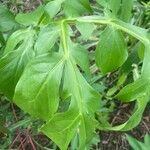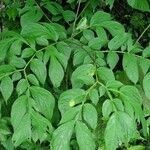Tuber massively thickened, 6–20 cm. broad or more, growing horizontally, with distinctive annular leaf-base scars and growing point situated obliquely.. Cataphylls 20–30 cm. long, 3–4 cm. broad, oblong, membranous, speckled, acute to subacute.. Petiole aculeate, up to 3 m. long, 1–4 cm. thick, dark to purplish green with whitish speckling; prickles whitish-green, 2–3 mm. long; blade up to 1.5 m. broad, ultimate lobes up to 20 cm. long, 10–13 cm. broad, dark green.. Peduncle 50–180 cm. long, 0.7–1 cm. or more thick, aculeate, with coloration similar to petiole.. Spathe oblong-ovate, green, greenish to purplish brown or brick red, 14–30 cm. long, 3–5 cm. in diameter, acuminate.. Spadix subcylindric, 10–20 cm. long, shorter than spathe, staminate part 7–12 cm. long, 1–1.5 cm. in diameter, narrowing slightly towards blunt apex, pistillate part 3–8 cm. long, 1.5–2 cm. in diameter.. Stamens subsessile, 2–2.5 mm. long, 1.5 mm. broad, cream-coloured to white.. Pistil 4 mm. long; ovary 2.5–3 mm. in diameter, glossy purple to pink; style up to 2 mm. long, sometimes very short, narrowing apically and ± sharply deflexed; stigma bilabiate, zygomorphic and V-shaped when viewed face-on, about 1 mm. in diameter, facing towards spadix-base, cream to purplish.. Berries oblong-ellipsoid, red to purplish, 1.5–2 cm. long, 0.8–1 cm. in diameter, rounded, umbonulate, 1-seeded.. Seed obovoid, 1.5 cm. long, 0.8 cm. in diameter, with prominent oblong raphe.
More
A large herb. It grows 2 m tall. It keeps growing from year to year. The leaf stalk is stout and has prickles. The plant grows 2 m high. The leaves are large and much divided. The bract around the flower is 20-25 cm long. The leaves arise from a tuber. The tuber is 80 cm long by 20 cm across. The fruit are red berries. The seeds are oval.


